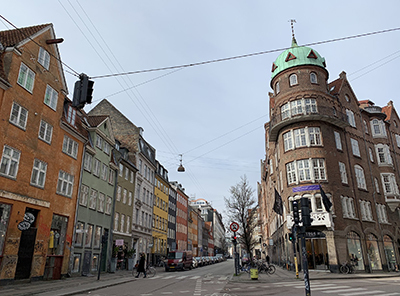
Sam Cannova ’21, a program of liberal studies major at the University of Notre Dame, traveled to Copenhagen with funding from a Nanovic Institute Spring Break Travel and Research Grant to investigate the efficacy of pay gap legislation design in Denmark, as well as glean insights into how policy plays a role in progressing gender equity throughout the European Union.
This article is the second in a series of blog posts published by the Nanovic Institute for European Studies. The Nanovic Navigator is home to stories told by our students about their unique experiences in Europe through our undergraduate grant programs. If you have questions about a story, a student, or the Nanovic Institute, please contact Anna Dolezal, student programs assistant manager (adolezal@nd.edu).

In 2019, a team of researchers from the United States and Europe published a paper showing the statistical effects of a 2006 amendment to Denmark’s Equal Pay Act, intended “to promote visibility and information about wage differentials”—despite the prevalence of transparency laws in developed labor markets, the authors argue that they have yielded only limited gains in closing pay gaps. Seeking to further understand the mechanisms at play in such a rollout by unpacking the quantitative results of this pay transparency legislation and learning how different Danish stakeholders view them, I traveled to Copenhagen with support from the Nanovic Institute to research pay gap legislation design, its effectiveness in Denmark, and how policy plays a role in progressing gender equity throughout the European Union.
Hoping to dive deeper into the findings of the paper, my Nanovic research began through interviews with one of the paper’s authors, Morten Bennedsen, and two of his colleagues at the University of Copenhagen. After probing Professor Bennedsen's personal insights on the future of pay gap legislation design, I met with his colleagues, one a sociologist, the other an economist, who regularly collaborate on research examining the labor markets in Denmark.
The most important finding from these interviews was the importance of collective bargaining, both to the Danish labor markets at large and to individual employers and employees. About 84% of all Danish employees (white and blue-collar) are covered by collective agreements. Even when huge multinational corporations, like McDonald's, have come to Denmark, they conform to the collective agreement model.
Quite surprisingly, I found that both employers and employees expressed dissatisfaction with Bennedsen’s research paper because it appears to validate legislative interference into collective agreements. Under the collective agreement model, employers and employees are generally happiest when the government has little to no involvement in their contracts. This doesn't mean, however, that social issues like pay gaps fall by the wayside. For example, Denmark is one of the only EU members without a legally-mandated minimum wage; yet, collective agreements between employers and employees have elevated the average effective minimum wage above that of the EU directive.
As I conducted interviews, one of the main difficulties I faced was adjusting my perspective as I learned more about the Danish labor markets. I knew that collective agreements were more common than they are in the U.S., but not to the full extent that my interviewees emphasized. About 68% of the Danish workforce is in a labor union, compared to about 10% in the U.S. As a result, collective bargaining plays a much larger role in pay gap policy than I had previously anticipated. In fact, my interviewees suggested that both the unions and employers were frustrated that the government passed any pay gap legislation to begin with, out of concern that the government would infringe on the collective agreement model.

I scheduled a third interview with a professor of economics at Copenhagen Business School to round out my perspective with insights on the private side of the labor markets, and a final meeting with KVINFO, a gender equity research center, where I hope to gather more notes from the teams involved in lobbying for pay gap policies.
Ultimately, I learned that the construction of Danish labor markets has a much more tangible influence over the pay gap than legislation. During the interviews, my curiosity turned towards comparisons between Denmark and other Nordic countries; their labor markets are run on the same model of collective bargaining, but Sweden, Norway, and Iceland have passed far stricter pay gap laws. Denmark's neighbors are also more progressive with benchmarking and earmarking policies like equal pay, parental leave, and work-life balance. Though it's difficult to offer a rigorous explanation, my interviewees suggested that it might be influenced by cultural norms or popular politics, while making it clear that this is a lingering question. In the future, I'd love to learn more about the nuances of how and why their similar economic models yield different behaviors and practices regarding pay gaps.
Aside from frequently checking updates to the news and Notre Dame correspondences, most of my day-to-day was unaffected by the spread of the coronavirus, besides substituting a handshake for an elbow bump with my interviewees. Unfortunately, due to the increased precautions surrounding the spread of the virus, the two interviews I scheduled for my last full day in Denmark had to be canceled without opportunity for rescheduling. However, I may still be able to ask a few questions via email or video conferencing! However disappointing it was to lose these two meetings, I’m very grateful for my conversations with the three other experts.
In the final two days of the week, and in response to the coronavirus outbreak, some of Copenhagen’s functions started to shut down—restaurants, public institutions, and universities. I remember how quiet the streets became, though this was not an uncommon experience as many people bike instead of drive in the city. In the spirit of Copenhagen, I jumped on a bike and used my remaining free time to explore different neighborhoods and communities in and around the city. I tried some local smørrebrød, went through a few food markets, and joined a community dinner in an industrial neighborhood. My most memorable afternoon was spent in Freetown Christiania, an intentional community and anarchist commune of about 1,000 residents residing about an abandoned military area within the city.
In the end, I learned quite a bit about how labor markets—particularly the influence collective agreement models have on labor markets—impact pay equity policies in Denmark. Given that equal pay is an increasingly heavy focus of the European Union, I’d love to gauge how different countries, despite differences in their labor markets, might strike a nuance to deliver different pay gap policies.
Originally published by at nanovic.nd.edu on July 07, 2020.